



D8-10 and Two Supplementary Reports Conference 2013
IEP reports Invercargill to Huntly have shown between 50-60% of Church buildings are earthquake prone – below 34% new building standard (NBS) ◦ North of Huntly reports being tendered but likely to be a similar results ◦ IEP an initial evaluation tool with a conservative bias ◦ Most buildings built before 1974 when seismic engineering standards introduced are likely to be below 34%
Percen centage of Appr prox Risk Building lding Grade ade New Build ildin ing Relative ive to a New Risk Descript cription Streng ngth Building lding (%NB NBS) S) A+>10 >100 >1 Low Risk A 80 to 100 1 to 2 Times Low Risk Low or Medium B 68 to 79 2 to 5 Times Risk C 34 to 67 5 to 10 Times Medium Risk D 20 to 33 10 to 25 Times High Risk E <20 More than 25 Very High Risk Times
“The probability of the earthquake strength of an earthquake prone building being exceeded in 50 years is around 70%” NZ Society of Earthquake Engineering “Buildings below 67% NBS can be expected to have significant damage during the design [strength] earthquake and it would not be expected that the building would remain in a useable condition following the design event. It should be noted that it is not considered a question of if an earthquake will hit, but more a question of when.” Chester Consultants, Auckland
Up to five years to determine NBS rating Up to 15 years to strengthen to 34% NBS or more Greater time allowance for listed historic buildings Possible exemption for small, infrequently used rural churches (not defined so far)
All IEPs within next six months Buildings considered to impose a significant risk to safety closed pending strengthening Other sub 34% buildings to have detailed engineering reports to enable costings of 34% and 67% NBS strengthening options Current strengthening to 67% NBS
Owners/managers are required to : ensure buildings are safe to occupy note that the statutory period to meet code requirements having not expired is not necessarily a defence if the buildings fail causing injury, damage or death inform users, where owners/managers know or on reasonable grounds should know that a building is earthquake prone once detailed investigations done, ensure all buildings have an NBS “rating” sign at entrances
Model del Deed d Tru rusts sts Fewer than a dozen remain Request to have all transferred by 31 October 2014 (Suggested decision 4)
Regis gistered tered Tru rusts ts The need for each proposed trust to be reviewed ◦ Importance of keeping parishes as the central administration unit Trusts must be subject to Church Law and Regulations to ensure ◦ Final authority lies with Conference ◦ Insurance covers are for Church controlled groups ◦ Trusts not subject to Conference decisions are not covered
Sugg gges ested ed Decision sion 5 General Secretary to give approval to any new trust which is, or purports to be, part of the Methodist Church of New Zealand Te Hahi Weteriana o Aotearoa. General Secretary to consider: Purpose of and need for the trust Alternative structures Wording of proposed trust deed MMA and Synod views and recommendations may be sought. If trust formed without approval, cannot use MCNZ GST or charitable registrations and not protected by insurance provisions.
Joint placement through AllChurches Risk Management with Anglican, Baptist, ACTS, Elim and Lutheran Churches. Discussions with Catholic Diocese to develop areas of common interest. Need for natural calamity cover reinforced by the recent “ Seddon Earthquakes” Full replacement cover the default position. Indemnity or Functional replacement cover available with Synod agreement – “average” applies
Func ncti tional onal Replacement acement Cove ver Insuring a defined alternative structure of lesser value than existing building Must be sufficiently defined to be valued “Average” applies if FRC is below 70% of replacement value of current building
Recommend
More recommend